A guide to uphill ski touring equipment
By David Nichol, Glasgow Ski Touring Club
In order to ski downhill we first have to haul ourselves upwards. What goes down must have gone up. Skiing developed thousands of year ago in the Northern regions of the world as an efficient method of winter travel. Over the last few decades the tourist industry has tried to convince us that skiing is a downhill only pursuit.
Once skiers have escaped from the control of the lift
companies we need to know a few techniques of ascent. Uphill skiing is skiing;
skiing is sliding around with skis on your feet. A typical day away from the
lifts might be spending eighty per cent of the time going uphill and twenty per
cent downhill. That uphill time lets you chat with your pals, check the snow
structure, become in tune with the world and start thinking snow zen thoughts.
Walking uphill with skis over your shoulder is not skiing; it's a bit like
swimming up a river with a kayak strapped to your back. Where should we go? Summit
ridges and plateaux become wind scoured and rock strewn. Most people will have
more fun when the trip is less about peak bagging and more about swooping.
Most of this article will refer to “nordic” style mountain touring skis, because they roam a bit further and have more technical options, but the simpler techniques can be applied by split board snowboarders and “alpine” skiers.
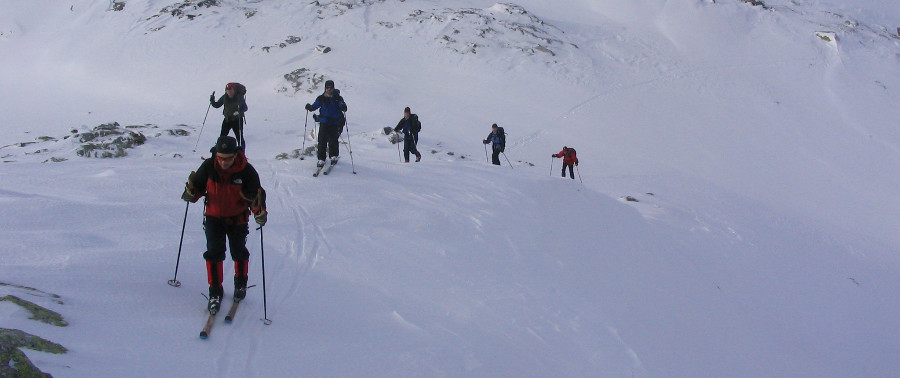
Lifts
At most ski areas it is possible to buy a single lift
ticket, entitling you to one ascent of the lift system. After being carried up
the front of the ski area, you leave the patrolled area at the top and
disappear down the back of the mountain. This is what is meant by the American
term “backcountry” skiing. This can be an expensive option, but useful if time
is limited.
The danger of lift assisted backcountry skiing is that you can quickly find yourself in a high mountain environment, away from the patrolled and groomed pistes. When you leave the cover of a patrolled ski area your personal safety margin decreases; you need to compensate by increasing your personal skill levels. If in foreign parts, your travel insurance may be invalidated. Steeper and more remote areas demand personal mountaineering skills, and snowfields anywhere demand knowledge of winter weather and cold injuries. Be sure of your equipment, skills and companions.
Skins
Climbing skins are strips of stout fabric which are stuck to
the bottom of skis, allowing the ski to grip the snow. As you might expect,
skins are not made from skin. They are usually a polyester material, woven to
give an artificial fur effect. Like cat fur, if you rub it one way it is smooth
but if you rub it the other way it will rise up and resist. This feature allows
forward travel while resisting backwards slips.
Skins need a bit of care and maintenance, They are fixed to
the base of the ski with a specialist glue, which needs periodic renewal. They
can pick up dirt from the ground, and can be cleaned using a bit of washing up
liquid and a nylon nail brush.
When not in use carry the skins in their bag inside your clothing, to maintain a working temperature in the glue. When putting them on, pick a safe spot, before you get into trouble.
In use the required gait is
shuffling, not kick and glide, keeping your centre of gravity over the centre
of your skis. Press the ski lightly into the snow for grip, keep the skins flat
and in contact with the snow. Be rhythmical. On steep ground, press harder with
shorter strides. Do not lean forward into a hill, you will fall. Swivel the
ankles to maintain maximum contact between skin and snow. The required ski technique
is a zig-zag ascent with kick turns. You are best learning this technique from
a more experienced skier; pay for instruction or join a club. A good set of
skins will allow a very direct up hill line; you can fit wedge like devices
called “heel lifts” to your bindings, they will take some pressure of your
ankles. If you want to spend a long day on the hills keep the angle of attack
relaxed. Working yourself hard while skinning will knacker yourself early; if
you can't hold a normal conversation with your pals while climbing you’re going
too fast.
If skins get wet, perhaps during a burn crossing, they can
ice up. Reduce this risk by rubbing in a water proofing coating such as
“Nikwax”.
Learn the technique for removing skins without having to take your skis off. This has huge advantages at the top of a wind blasted pass. Lean on one pole, cross the heel of the ski in front of the opposite shin, grab hold of the back end of the skin and rip it off.
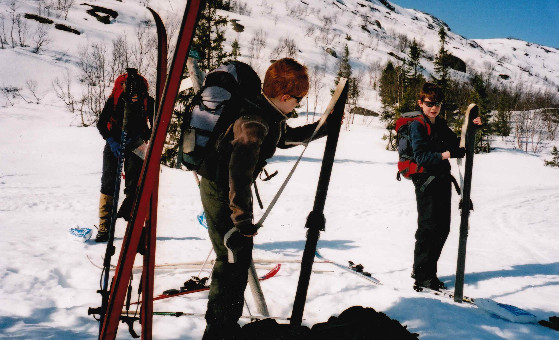
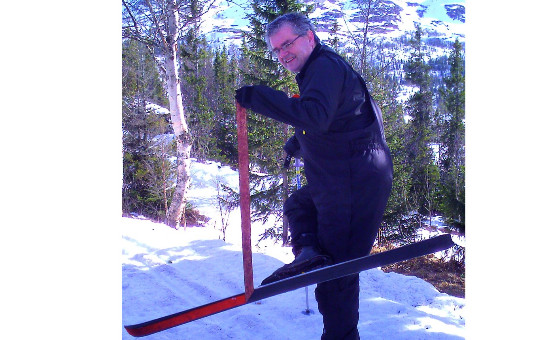
Apart from hill climbing, the
other use for skins is for when the visibility drops to the point where it
becomes necessary to pace out distance. With practise, this can be done
reliably on skins.
When buying, choose your skins to suit what is likely to be
your main activity. If you expect to do a lot of up and down on very steep
slopes you will want wide skins tailored to match your wide carving skis; if
you want to do longer distances on more moderate slopes then narrower, cheaper,
skins will do.
Fishscales
There is a common myth that fishscale skis “won't turn”;
this stems from one of the early designs of skis with plastic bases, which had
the scales sticking out of the base. The turning performance of modern
fishscale skis is indistinguishable from their smooth bottomed counterparts. It
is said that fishscale skis are slower than waxing skis, due to extra friction.
Over a day, fishscale users usually lose a lot less time faffing compared with
wax users, while the slower downhill speed is compensated for by taking a more
direct downhill line.
Fishscale skis are often referred to as “wax-less” skis;
this is a misnomer. Fishscale skis need the front and back section to be
treated with glide wax; the middle, scaly, section should be treated with a
liquid furniture polish in order to keep it clean and reduce snow “balling”.
You might have noticed that winter temperatures in Scotland can go up and down like a yo-yo. Sometimes we have two weather fronts pass through in a day, with maybe a fifteen degree temperature change between them. This has a huge effect on skiing conditions. Fishscales are much more resilient to temperature change than “grip” waxing skis. On steeper ground skins can be used with fishscales, just like any other ski.
Grip waxing
Most information published about nordic ski waxing is
written for ski racers; this can be a bit intimidating and over complicated.
This article aims to provide the minimum knowledge required for ski tourers in
Scotland. If you want the full scientific view, the wax manufacturers websites
can provide chapter and verse.
Waxes have design temperature ranges; cold waxes are harder. Waxes with the words “Extra” or “Special” in their name have a wider effective temperature range and are, therefore, more useful. Waxes called “universal” have a very wide range. Check the temperatures printed on the side of the packet. Some manufacturers refer to snow temperature, while others refer to air temperature. The snow surface temperature is generally about three degrees lower than the air temperature. A little “keyring” thermometer is useful.
Rub the grip wax on like a crayon. It goes onto the part of the ski base indicated on our diagram, from just behind the boot heel to about one boot length in front of the toe. You might see a slight improvement in performance if you then rub the new wax with a cork.
If you are slipping when going up hill on places that should be easy you need more wax; perhaps make the wax pocket a bit longer.
“Klister” is the Norwegian word for glue and is the name given to the very sticky form of grip wax, which usually comes in tubes like toothpaste. Klister is for grip on ice or melting snow. Wipe it on with pressure from the heel of your hand.
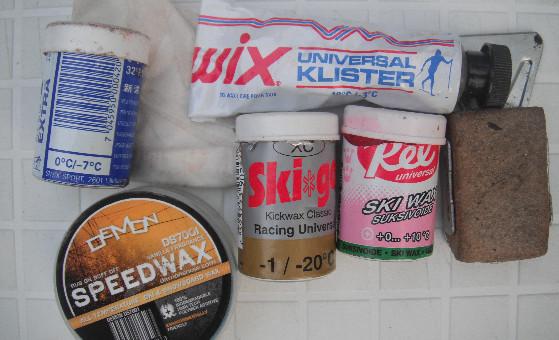
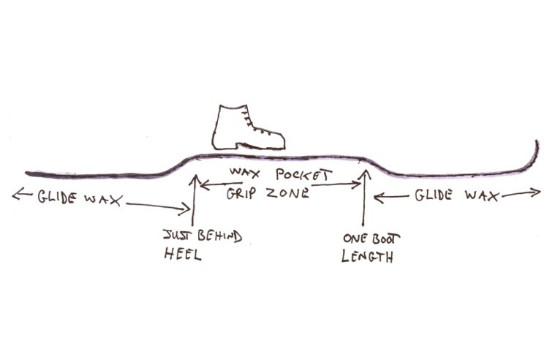
If your skis “ball up” with snow, give it a kick or wipe. If it keeps happening, your wax is too soft; scrape it off and replace with a colder wax.
A citrus based cleaning fluid is useful for softening old wax for removal, then scrape before wiping with a paper towel or rag. The grade of paper towel which is given away free at petrol stations works well. If you run out of solvent on a multi day trip, then rubbing butter or margarine in to old grip wax with your finger will soften the wax enough to make scrapping it off easier.
While we have been referring to waxes in tubes and sticks, universal grip waxes, klisters and cleaning fluids are also available in aerosol tins. These are very easy to use but are more expensive and may be troublesome if you are trying to negotiate airport security.
Suppliers
Finding a source of quality, appropriate, ski touring equipment can be a problem in Scotland. There are shops in the main towns in the Cairngorm area which have small, random, stocks of kit which usually seem to be the left overs of the ski lift user. If you try phrases like “cross country ski” , “XC wax”, or “biathlon ski shop” in your favourite internet search engine you will discover online selling from the Cairngorm shops; a cross country ski shop near that well known ski area, Brighton; a shop in Chippenham, which specialises in ski biathlon; a big “telemark” company with Scottish connections in the Pyrenees; an XC company in Bunde, in the Netherlands, with a very comprehensive range of ski waxes, and a couple of places selling small ranges of alpine touring kit. Over the years your author has bought kit from all of these and couldn't recommend or criticise any of them more than the others.
The equipment is less important than the experience. Get out there and do it. Skiing uphill is about being part of the environment, where you can hear the silence.